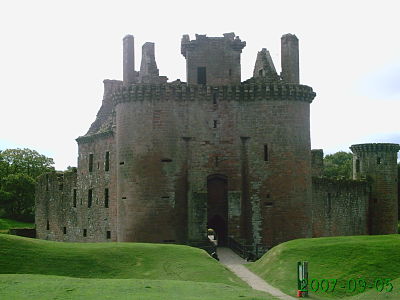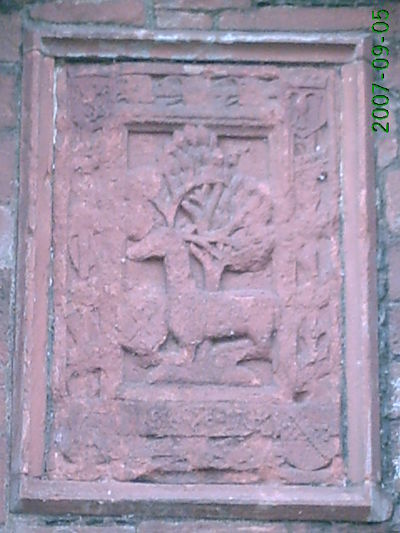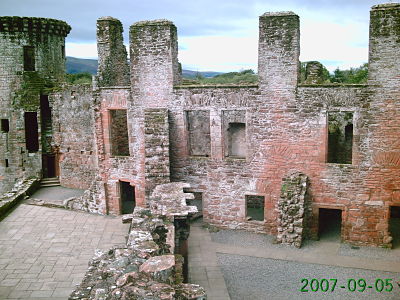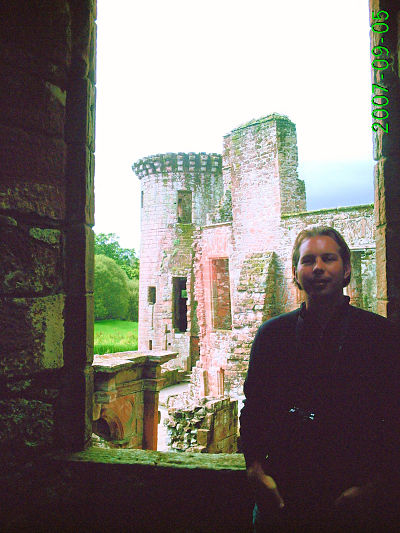



Caerlaverock is one of the finest examples that you will find still standing of a 13th century medieval fortress. The castle is on a coastal loop of the B725 highway, 5 miles West of Ruthwell, less than a half hours drive South of Dumfries. It is a triangular design, unique to Britain. The moated fortress has solid sandstone masonry and an imposing double tower gatehouse.
Caerlaverock, along with Lochmaben Castle and Threave Castle, were the main defenses along the Scotland England border and, therefore, historical points in the ongoing Border Wars. In about 1220, Alexander II of Scotland granted the lands of Caerlaverock to a new-comer from the Eastern Borders - Sir John de Maccuswell (Maxwell). The Maxwells built one castle which was prone to flooding, so around 1270, they built the present castle, where they lived until 1640. From the road above the castle, visitors can see the Solway Firth lying between Scotland and England. This proximity to England caused much blood to be shed over the castle. For 400 years the castle was frequently attacked, ravaged and repaired. Amazingly, the Maxwell family managed to stay in possession, despite the castle being twice described as "levelled to the ground". Eventually in 1640, after being besieged for over 3 months, it was conquered for the last time and again partly dismantled.

In 1291, Sir Herbert Maxwell, John's nephew, was one of the nobles appointed to choose a successor to Margaret, the daughter of Alexander III who died at the age of 7. The new King John's reign ended in 1296 when Edward I of England invaded Scotland. The invasion caused many Scots to swear loyalty to Edward I, among them being Herbert Maxwell and his son John. When the Scots still resisted Edward I, he came back to Scotland in 1300 and invaded Galloway, one of the strongest areas of resistance. Caerlaverock Castle was a prime target. Edward brought 87 knights and 3,000 men to Caerlaverock. The defense of the castle fell to Robert de Cunningham, valet to the Steward of Scotland and his garrison of just 60 men. After the seige engines arrived from the castles of Lochmaben and several other castles, the garrison could only withstand 2 days of pummeling from the projectiles. Thanks to a detailed account of the battle from a herald in Edward's army, this became one of the best known military operations of the Wars.
The castle remained in English hands until 1312 when the keeper was Sir Eustace Maxwell - demonstrating this family's ability to "bend with the prevailing wind". He then changed sides and declared for King Robert I (the Bruce). When Robert's son, David II, became King in 1329, Sir Eustace changed sides again to support Edward Balliol.

Despite their pro-Balliol stance during the Wars of Independence, the Maxwells held on to Caerlaverock. Rebuilding work began in the 1370's, and much of what stands today dates from that time, over 600 years ago. By the early 1400's, the Maxwells were solidly entrenched with Herbert Maxwell being created Lord Maxwell and Robert, the 2nd Lord, appointed Warden of the Scottish West March. In 1513, the family lost John, the 4th Lord, and 3 of his brothers at the bloody Battle of Flodden against Henry VIII. However, Robert, the 5th Lord, became regent of Scotland in 1536 during James V's temporary absence in France. The family then controlled most of the major places of strength in the area, including the castles of Lochmaben and Threave.
Through all this time,the Maxwells remained devout Catholics. Even after the reformation of 1560, they played a dangerous game, which included a trip to Spain in the 1580's to help arrange the Armada invasion. In 1603, James VI's accession to the English throne as James I brought peace to the Border region. In 1620, Robert Maxwell was elevated to Earl of Nithsdale. He was one of Charles I most loyal supporters, but Charles could not support him when the Covenanter army besieged Caerlaverock for 13 weeks in 1640. After this seige, the Covenanters partially dismantled the castle to make it incapable of further defense. Since then, the castle fell into decay.

Caerlaverock castle passed by inheritance through the family of Herries - a branch of the Maxwell family - to the Dukes of Norfolk. In recent generations, inheritance has gone through the female line via the Duke of Norfolk to his daughters, Lady Herries and Lady Mary Mumford. In 1946, the 16th Duke placed the castle in state care. All of the castles mentioned in this article are now part of the over 30 sites in Dumfries and Galloway now cared for by Historic Scotland.
Additional history and pictures of the castle can be obtained from this link.
Family Name Christmas GiftsClick on the item below for merchandise with the family name or crest
Related Names To request another name - email webmaster@carothers-carruthers.com |
||
Search This Site by Keyword |
||
** Records of the Carruthers Family **The book Records of the Carruthers Family is now available in serialized .pdf form from this web site. New sections will be added monthly. Click on the above link to go to the page with the sections. |
||
|
|
||
|
Genealogists |
||
|
|
||
|
||||||||||
|
|
||
Sponsored Links |
||
Site Map - Click "+" to see all pages |
||
webmaster@carothers-carruthers.com


